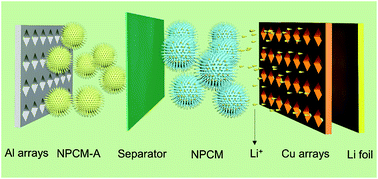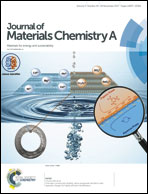Highly stable lithium ion capacitor enabled by hierarchical polyimide derived carbon microspheres combined with 3D current collectors†
Abstract
Lithium ion capacitors (LICs), which combine the merits of both lithium ion batteries and supercapacitors, have recently attracted considerable attention. However, LICs generally use different materials and synthesis routes for the cathode and anode, resulting in a complicated process and high production cost, from an energy storage device perspective. In addition, the current collector interface structure design plays a key role in the electrochemical process. Herein, we have designed and fabricated a novel LIC with similar-symmetric architecture in both electrodes. The nitrogen-doped porous carbon microspheres (NPCM) derived from the hierarchical assembly of polyimide nanosheets as the anode material showed excellent lithium storage properties. The cathode material (NPCM-A) obtained by the activation of NPCM led to an ultrahigh specific surface area (2007 m2 g−1) and excellent capacitance characteristics. Benefiting from the unique superstructure and 3D porous array current collectors, the novel LIC achieved a high energy density of 95.08 W h kg−1 and could retain 48.2 W h kg−1 even at a high power density of 15 kW kg−1 on the basis of mass of both electrodes. Moreover, the LIC achieved 80.1% capacity retention after 5000 ultra-long cycles, corresponding to fading of 0.004% per cycle.



 Please wait while we load your content...
Please wait while we load your content...